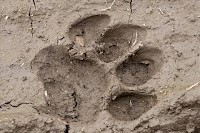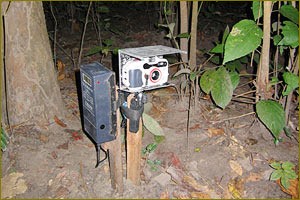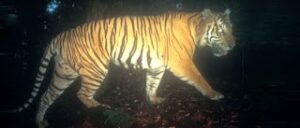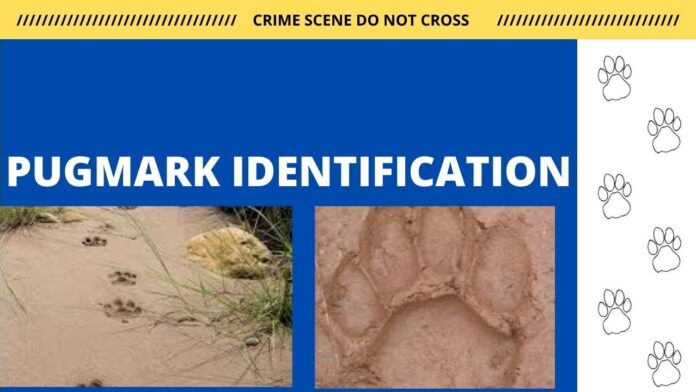Pug Impression Pads ( PIP ) Techniques to Trace Leopard
The Pugmark Census was put into practice across India in 1966. As part of the census, a Pug Impression Pad (PIP), is prepared by a layer of fine soil about 2 cm thick on forest paths so that animals will leave good footprint impressions. Individual tigers were identified based on perceived differences in pugmark shape and size metrics. It yielded estimates of 296 tigers in 1989 for the Indian Sundarbans.
However, the validity of pugmark method was questioned by Dr. Ullas Karanth and other scientists, who pointed out its failures through multiple research papers. They critically reviewed the shortcomings of this technique, pointed out the poor quality of pugmark tracings, differences between personnel skills and the biologically unrealistic assumption that all tigers can be individually detected, which led to inaccurate estimates of tiger numbers. Responding to these critiques, the Tiger Task Force (2005) finally abolished the pugmark census method with the camera capturing and re-capturing method.
THE FIRST all-India tiger census in 1972 was designed by then senior research officer Saroj Raj Choudhury and his trainees at the Forest Research Institute in Dehra Dun. The method used the hind pugs left by a tiger. No matter how the tiger walks, its hind pugs are usually clear. The hind pug is smaller than the front pug and presents features that can help distinguish not only between male and female tigers, but also the left and right paws.
The pug of a tiger cub and that of an adult leopard are almost equal in size and never more than 9 cm long. In the refined technique (Indian Forester, Vol. 116, No. 3), the strides are measured — there are longer strides in a leopard’s track because an adult leopard has a longer body and higher limbs than a tiger cub.
To distinguish between male and female tigers, a technique formulated in 1979 by H S Panwar, in which the male tiger’s hind pug is taken to fit into an almost square frame, while the female’s fits into a rectangular frame, is used. In a refinement of this technique, a difference of upto 1.5 cm between the length and width of the pug is allowed in the square against which male pugs are measured (Indian Forester, Vol. 117, No. 1).
The census is taken over 6-8 days so as to allow pugs to be double-checked. Pugs seen in one area are compared with those in adjacent areas before final figures of leopards, tigers, pug sizes, strides and movement areas are catalogued and mapped. To meet these requirements, pugs on the ground are so translated that the transcriptions are true, portable and storable. The accurate features of the pug are drawn on a “tiger tracer”, a glass sheet measuring 30 x 25 cm, which is placed on it.
Plaster-casts of the pugs are also necessary because a tiger census is a large-scale operation and not everyone follows the same standards while tracing pugs. In Similipal for example, there are 45 census units involving more than 150 persons, 253 census routes and nearly 3,700 PIPs (pug impression pads) scattered over a total route length of 1,240 km. A pug impression pad is fine soil placed over roads, footpaths and animal tracks so that the tigers will leave their pugs on it.
Wildlife students often wonder how we can be sure that a tiger hasn’t been overlooked. Each Project Tiger area represents a different biome, which is a large, naturally occurring community of flora and fauna, adapted to the particular conditions in which they occur. In difficult and inaccessible terrains, it is quite possible that we may miss one or two tigers. Recounting a tiger, however, is impossible because of the extremely rigorous process of elimination involved in a census.
No single census procedure can be applied to all tiger reserves. In Similipal, water is not a limiting factor, but as PIPs are used, they must be laid when the forest is not open. Hence, December is the census month in Similipal, though in most other areas, it takes place in the summer. Counting pugs is the most reliable and economical method of tiger census. Field-data obtained through counting pugs can be preserved as tracings or plaster casts for study, comparison and reference. The method also allows ample scope for refinement.
Collecting pugmark is a complicated procedure and the first step is laying out of pugmark impression pads (pips). These are random two metre patches of fine earth spread along the width of the track laid out in such a way that at least one of them registers a tiger walking past. To lay out the PIP, the soil is removed to a depth of at least 0.02-0.03 metres and the area filled up with fine earth sieved through a wiremesh.
The search for pugmarks is carried out all along jeep tracks, riverbanks, beds of dry streams, firelines and water holes. To record, the best hind pugmark of the right or left paw is selected. If no hind pugmark is available then the front pugmark is selected but this makes the determination of sex difficult.
Though impressions of all four pug marks are left on the ground, only the hind mark usually remains undisturbed by the tiger’s walk and remains intact for recording. This is because, during a normal walk the hind paw comes to rest wholly or partly upon the corresponding front paw — left upon left and right upon right. During a slow walk, the hind pugmark falls behind the impression left by the front paw. And during a fast walk the hind paw goes ahead and falls in front of the front pugmark.
The PUGMARK census was invented in 1966 by Indian forester SR Choudhary. In this method, during a 1-2 week period, many personnel simultaneously place the PIP’s (Pug Impression pads) in Tiger tracks ( Tigers normally use human paths. Also tiger spat is located to find out the tracks). The PIP’s are then collected and analysed to find the number of Tigers. The pug mark of each animal is distinct. This method gives minimum number of tigers in that region but we cant be sure that every tiger has left its mark on the pads. Experts can even tell the sex and age of the species using the pug mark. 
The latest method is camera trapping where cameras are placed along the tiger paths. These cameras get triggered by the HEAT and MOTION of the animal. The pictures from all the cameras are collected and analysed to find out the number because same tiger might have been photographed more than once. An interesting fact about Tigers is that the Stripes on each tiger is distinct. This helps us pick out the photo’s of same tiger.

Both these methods leaves us with a doubt because we cant get all the tigers caught. There are other methods to estimate the number of tigers where Mathematics ( to be specific PROBABILITY AND STATISTICS) helps us.
Another fact that each Tiger has its own perimeter and they are evenly distributed in a region is used as a key. The spat (excreta) sample is collected from a particular region. The DNA analysis of this tells us the distinct number of tigers present in that area. After about a week, the same procedure is undertaken again. This time many samples which were not found in the first attempt may be found. The data’s from each sampling is used to compute and finally arrive at an Estimated number.
- The estimated number is often cross checked with the PREYpopulation in that region. Prey population plays a key role. Tiger population is proportional to the Prey population.
- The field tests are conducted in SUMMER when the availability of WATER is limited and as every animal needs water, traps placed near Waterholes will help us get a better estimation.
 |
A Tiger camera trapped is shown in this picture
Compiled & Shared by- This paper is a compilation of groupwork provided by the Team, LITD (Livestock Institute of Training & Development)
Image-Courtesy-Google
Reference-On Request



